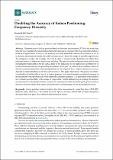Doubling the Accuracy of Indoor Positioning: Frequency Diversity
Author(s)
Horn, Berthold K. P.
Downloadsensors-20-01489.pdf (3.464Mb)
Publisher with Creative Commons License
Publisher with Creative Commons License
Creative Commons Attribution
Terms of use
Metadata
Show full item recordAbstract
Determination of indoor position based on fine time measurement (FTM) of the round trip time (RTT) of a signal between an initiator (smartphone) and a responder (Wi-Fi access point) enables a number of applications. However, the accuracy currently attainable—standard deviations of 1–2 m in distance measurement under favorable circumstances—limits the range of possible applications. An emergency worker, for example, may not be able to unequivocally determine on which floor someone in need of help is in a multi-story building. The error in position depends on several factors, including the bandwidth of the RF signal, delay of the signal due to the high relative permittivity of construction materials, and the geometry-dependent “noise gain” of position determination. Errors in distance measurements have unusal properties that are exposed here. Improvements in accuracy depend on understanding all of these error sources. This paper introduces “frequency diversity,” a method for doubling the accuracy of indoor position determination using weighted averages of measurements with uncorrelated errors obtained in different channels. The properties of this method are verified experimentally with a range of responders. Finally, different ways of using the distance measurements to determine indoor position are discussed and the Bayesian grid update method shown to be more useful than others, given the non-Gaussian nature of the measurement errors.
Date issued
2020-03Department
Massachusetts Institute of Technology. Department of Electrical Engineering and Computer ScienceJournal
Sensors
Publisher
MDPI AG
Citation
Horn, Berthold K. P. "Doubling the Accuracy of Indoor Positioning: Frequency Diversity." Sensors 20, 5 (March 2020): 1489 © 2020 Author
Version: Final published version
ISSN
1424-8220